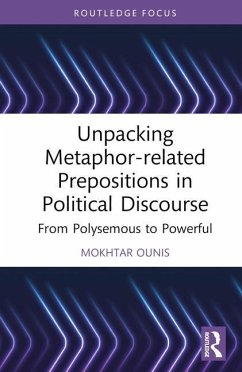Mokhtar Ounis
Unpacking Metaphor-related Prepositions in Political Discourse
From Polysemous to Powerful
Mokhtar Ounis
Unpacking Metaphor-related Prepositions in Political Discourse
From Polysemous to Powerful
- Gebundenes Buch
- Merkliste
- Auf die Merkliste
- Bewerten Bewerten
- Teilen
- Produkt teilen
- Produkterinnerung
- Produkterinnerung
This book explores the context around why English prepositions are used in figurative language more frequently than nouns and verbs, using corpus-based evidence to examine the most often used prepositions and how they are employed and for what purpose.
While research on cognitive approaches to metaphor has significantly expanded in recent decades, little attention has been paid to prepositions as vehicles of figurative language, owing to their polysemous, complex, and inconsistent nature. To bridge this gap, Ounis introduces an innovative conceptual framework that integrates conceptual…mehr
Andere Kunden interessierten sich auch für
![Introducing Pragmatics Introducing Pragmatics]() Louise CummingsIntroducing Pragmatics43,99 €
Louise CummingsIntroducing Pragmatics43,99 €![Systemic Functional Linguistics Systemic Functional Linguistics]() Christian M.I.M. MatthiessenSystemic Functional Linguistics138,99 €
Christian M.I.M. MatthiessenSystemic Functional Linguistics138,99 €![Meaning Meaning]() Betty J. Birner (USA Northern Illinois University)Meaning47,99 €
Betty J. Birner (USA Northern Illinois University)Meaning47,99 €![Everyday Linguistics Everyday Linguistics]() Joanne CavallaroEveryday Linguistics165,99 €
Joanne CavallaroEveryday Linguistics165,99 €![Everyday Linguistics Everyday Linguistics]() Joanne CavallaroEveryday Linguistics47,99 €
Joanne CavallaroEveryday Linguistics47,99 €![Language and Power Language and Power]() Paul Simpson (University of Liverpool)Language and Power51,99 €
Paul Simpson (University of Liverpool)Language and Power51,99 €![The Routledge Handbook of Metaphor and Language The Routledge Handbook of Metaphor and Language]() The Routledge Handbook of Metaphor and Language50,99 €
The Routledge Handbook of Metaphor and Language50,99 €-
-
-
This book explores the context around why English prepositions are used in figurative language more frequently than nouns and verbs, using corpus-based evidence to examine the most often used prepositions and how they are employed and for what purpose.
While research on cognitive approaches to metaphor has significantly expanded in recent decades, little attention has been paid to prepositions as vehicles of figurative language, owing to their polysemous, complex, and inconsistent nature. To bridge this gap, Ounis introduces an innovative conceptual framework that integrates conceptual metaphor theory, diachronic linguistics, and discourse pragmatics. Drawing upon an extensive corpus of American presidential inaugural addresses, this book considers the linguistic, conceptual, pragmatic, and contextual dimensions of English prepositions, revealing the fascinating interplay between language, culture, and cognition.
This volume will be of interest to scholars in pragmatics, metaphor studies, English language, rhetoric studies, and historical linguistics.
While research on cognitive approaches to metaphor has significantly expanded in recent decades, little attention has been paid to prepositions as vehicles of figurative language, owing to their polysemous, complex, and inconsistent nature. To bridge this gap, Ounis introduces an innovative conceptual framework that integrates conceptual metaphor theory, diachronic linguistics, and discourse pragmatics. Drawing upon an extensive corpus of American presidential inaugural addresses, this book considers the linguistic, conceptual, pragmatic, and contextual dimensions of English prepositions, revealing the fascinating interplay between language, culture, and cognition.
This volume will be of interest to scholars in pragmatics, metaphor studies, English language, rhetoric studies, and historical linguistics.
Produktdetails
- Produktdetails
- Routledge Research on New Waves in Pragmatics
- Verlag: Routledge / Taylor & Francis
- Seitenzahl: 120
- Erscheinungstermin: 27. November 2023
- Englisch
- Abmessung: 222mm x 145mm x 10mm
- Gewicht: 267g
- ISBN-13: 9781032431611
- ISBN-10: 103243161X
- Artikelnr.: 69433372
- Herstellerkennzeichnung
- Libri GmbH
- Europaallee 1
- 36244 Bad Hersfeld
- gpsr@libri.de
- Routledge Research on New Waves in Pragmatics
- Verlag: Routledge / Taylor & Francis
- Seitenzahl: 120
- Erscheinungstermin: 27. November 2023
- Englisch
- Abmessung: 222mm x 145mm x 10mm
- Gewicht: 267g
- ISBN-13: 9781032431611
- ISBN-10: 103243161X
- Artikelnr.: 69433372
- Herstellerkennzeichnung
- Libri GmbH
- Europaallee 1
- 36244 Bad Hersfeld
- gpsr@libri.de
Mokhtar Ounis is a linguist who earned his PhD from the University of Toulon in France, where he conducted research on the use of conceptual metaphors in political communication. He has been a faculty member at the University of Hail in Saudi Arabia for ten years, where he has taught courses in linguistics and related fields.
Contents
Preface
1. Chapter 1: Introduction
1.1. Defining key terms
1.2. Scope of this study
1.3. Structure of this book
2. Chapter 2: Navigating Prepositions
2.1. Defining prepositions
2.2. Polysemy: networks and principles
2.3. Cognitive grammar's view of prepositions
2.4. Prepositions' cognitive potential
2.5. Prepositions' contextual dynamics
2.6. Prepositions' axiological framing
3. Chapter 3: Metaphor: Insights from Classical and Cognitive Approaches
3.1. Classical views on metaphor
3.2. Cognitive view on metaphor
4. Chapter 4: The Power of Prepositions in Political Discourse
4.1. Political language
4.2. The history of political discourse analysis
4.3. The inaugural addresses and their generic properties
4.4. Conceptual metaphors in political discourse
4.5. The evolution trends of inaugural addresses
4.6. Metaphor variation and diachronic approach
5. Chapter 5: A Prepositional Portrait: Corpus and Frequency
5.1. Corpus linguistics and metaphor research
5.2. The Inaugural Corpus
5.3. The prepositions' frequency patterns
5.4. Tracking the preposition-to-word ratio
6. Chapter 6 Unpacking Metaphorical Patterns
6.1. Conceptual mappings of the metaphor-related prepositions
6.2. System metaphors and cross-system mapping
6.3. The coherence of metaphors
6.4. Prepositions and their metonymic basis
6.5. Conceptual notation revisited
7. Chapter 7: Beyond Spatial Metaphors
7.1. The cognitive model: an overview
7.2. Conceptual identity
7.3. Conceptual space
8. Chapter 8: Tracing Patterns of Change and Stability
8.1. Metaphor variations
8.2. Patterns of diachronic variations
9. Chapter 9: Concluding Remarks
9.1. How are prepositions distributedin the Inaugural Corpus?
9.2. What is the conceptual basis of metaphor-related prepositions?
9.3. How do metaphor-related prepositions mix?
9.4. Do metaphor-related prepositions reflect any systematic conceptualizations?
9.5. How do metaphor-related prepositions vary across history?
9.6. Final words
Index
Preface
1. Chapter 1: Introduction
1.1. Defining key terms
1.2. Scope of this study
1.3. Structure of this book
2. Chapter 2: Navigating Prepositions
2.1. Defining prepositions
2.2. Polysemy: networks and principles
2.3. Cognitive grammar's view of prepositions
2.4. Prepositions' cognitive potential
2.5. Prepositions' contextual dynamics
2.6. Prepositions' axiological framing
3. Chapter 3: Metaphor: Insights from Classical and Cognitive Approaches
3.1. Classical views on metaphor
3.2. Cognitive view on metaphor
4. Chapter 4: The Power of Prepositions in Political Discourse
4.1. Political language
4.2. The history of political discourse analysis
4.3. The inaugural addresses and their generic properties
4.4. Conceptual metaphors in political discourse
4.5. The evolution trends of inaugural addresses
4.6. Metaphor variation and diachronic approach
5. Chapter 5: A Prepositional Portrait: Corpus and Frequency
5.1. Corpus linguistics and metaphor research
5.2. The Inaugural Corpus
5.3. The prepositions' frequency patterns
5.4. Tracking the preposition-to-word ratio
6. Chapter 6 Unpacking Metaphorical Patterns
6.1. Conceptual mappings of the metaphor-related prepositions
6.2. System metaphors and cross-system mapping
6.3. The coherence of metaphors
6.4. Prepositions and their metonymic basis
6.5. Conceptual notation revisited
7. Chapter 7: Beyond Spatial Metaphors
7.1. The cognitive model: an overview
7.2. Conceptual identity
7.3. Conceptual space
8. Chapter 8: Tracing Patterns of Change and Stability
8.1. Metaphor variations
8.2. Patterns of diachronic variations
9. Chapter 9: Concluding Remarks
9.1. How are prepositions distributedin the Inaugural Corpus?
9.2. What is the conceptual basis of metaphor-related prepositions?
9.3. How do metaphor-related prepositions mix?
9.4. Do metaphor-related prepositions reflect any systematic conceptualizations?
9.5. How do metaphor-related prepositions vary across history?
9.6. Final words
Index
Contents
Preface
1. Chapter 1: Introduction
1.1. Defining key terms
1.2. Scope of this study
1.3. Structure of this book
2. Chapter 2: Navigating Prepositions
2.1. Defining prepositions
2.2. Polysemy: networks and principles
2.3. Cognitive grammar's view of prepositions
2.4. Prepositions' cognitive potential
2.5. Prepositions' contextual dynamics
2.6. Prepositions' axiological framing
3. Chapter 3: Metaphor: Insights from Classical and Cognitive Approaches
3.1. Classical views on metaphor
3.2. Cognitive view on metaphor
4. Chapter 4: The Power of Prepositions in Political Discourse
4.1. Political language
4.2. The history of political discourse analysis
4.3. The inaugural addresses and their generic properties
4.4. Conceptual metaphors in political discourse
4.5. The evolution trends of inaugural addresses
4.6. Metaphor variation and diachronic approach
5. Chapter 5: A Prepositional Portrait: Corpus and Frequency
5.1. Corpus linguistics and metaphor research
5.2. The Inaugural Corpus
5.3. The prepositions' frequency patterns
5.4. Tracking the preposition-to-word ratio
6. Chapter 6 Unpacking Metaphorical Patterns
6.1. Conceptual mappings of the metaphor-related prepositions
6.2. System metaphors and cross-system mapping
6.3. The coherence of metaphors
6.4. Prepositions and their metonymic basis
6.5. Conceptual notation revisited
7. Chapter 7: Beyond Spatial Metaphors
7.1. The cognitive model: an overview
7.2. Conceptual identity
7.3. Conceptual space
8. Chapter 8: Tracing Patterns of Change and Stability
8.1. Metaphor variations
8.2. Patterns of diachronic variations
9. Chapter 9: Concluding Remarks
9.1. How are prepositions distributedin the Inaugural Corpus?
9.2. What is the conceptual basis of metaphor-related prepositions?
9.3. How do metaphor-related prepositions mix?
9.4. Do metaphor-related prepositions reflect any systematic
conceptualizations?
9.5. How do metaphor-related prepositions vary across history?
9.6. Final words
Index
Preface
1. Chapter 1: Introduction
1.1. Defining key terms
1.2. Scope of this study
1.3. Structure of this book
2. Chapter 2: Navigating Prepositions
2.1. Defining prepositions
2.2. Polysemy: networks and principles
2.3. Cognitive grammar's view of prepositions
2.4. Prepositions' cognitive potential
2.5. Prepositions' contextual dynamics
2.6. Prepositions' axiological framing
3. Chapter 3: Metaphor: Insights from Classical and Cognitive Approaches
3.1. Classical views on metaphor
3.2. Cognitive view on metaphor
4. Chapter 4: The Power of Prepositions in Political Discourse
4.1. Political language
4.2. The history of political discourse analysis
4.3. The inaugural addresses and their generic properties
4.4. Conceptual metaphors in political discourse
4.5. The evolution trends of inaugural addresses
4.6. Metaphor variation and diachronic approach
5. Chapter 5: A Prepositional Portrait: Corpus and Frequency
5.1. Corpus linguistics and metaphor research
5.2. The Inaugural Corpus
5.3. The prepositions' frequency patterns
5.4. Tracking the preposition-to-word ratio
6. Chapter 6 Unpacking Metaphorical Patterns
6.1. Conceptual mappings of the metaphor-related prepositions
6.2. System metaphors and cross-system mapping
6.3. The coherence of metaphors
6.4. Prepositions and their metonymic basis
6.5. Conceptual notation revisited
7. Chapter 7: Beyond Spatial Metaphors
7.1. The cognitive model: an overview
7.2. Conceptual identity
7.3. Conceptual space
8. Chapter 8: Tracing Patterns of Change and Stability
8.1. Metaphor variations
8.2. Patterns of diachronic variations
9. Chapter 9: Concluding Remarks
9.1. How are prepositions distributedin the Inaugural Corpus?
9.2. What is the conceptual basis of metaphor-related prepositions?
9.3. How do metaphor-related prepositions mix?
9.4. Do metaphor-related prepositions reflect any systematic
conceptualizations?
9.5. How do metaphor-related prepositions vary across history?
9.6. Final words
Index
Contents
Preface
1. Chapter 1: Introduction
1.1. Defining key terms
1.2. Scope of this study
1.3. Structure of this book
2. Chapter 2: Navigating Prepositions
2.1. Defining prepositions
2.2. Polysemy: networks and principles
2.3. Cognitive grammar's view of prepositions
2.4. Prepositions' cognitive potential
2.5. Prepositions' contextual dynamics
2.6. Prepositions' axiological framing
3. Chapter 3: Metaphor: Insights from Classical and Cognitive Approaches
3.1. Classical views on metaphor
3.2. Cognitive view on metaphor
4. Chapter 4: The Power of Prepositions in Political Discourse
4.1. Political language
4.2. The history of political discourse analysis
4.3. The inaugural addresses and their generic properties
4.4. Conceptual metaphors in political discourse
4.5. The evolution trends of inaugural addresses
4.6. Metaphor variation and diachronic approach
5. Chapter 5: A Prepositional Portrait: Corpus and Frequency
5.1. Corpus linguistics and metaphor research
5.2. The Inaugural Corpus
5.3. The prepositions' frequency patterns
5.4. Tracking the preposition-to-word ratio
6. Chapter 6 Unpacking Metaphorical Patterns
6.1. Conceptual mappings of the metaphor-related prepositions
6.2. System metaphors and cross-system mapping
6.3. The coherence of metaphors
6.4. Prepositions and their metonymic basis
6.5. Conceptual notation revisited
7. Chapter 7: Beyond Spatial Metaphors
7.1. The cognitive model: an overview
7.2. Conceptual identity
7.3. Conceptual space
8. Chapter 8: Tracing Patterns of Change and Stability
8.1. Metaphor variations
8.2. Patterns of diachronic variations
9. Chapter 9: Concluding Remarks
9.1. How are prepositions distributedin the Inaugural Corpus?
9.2. What is the conceptual basis of metaphor-related prepositions?
9.3. How do metaphor-related prepositions mix?
9.4. Do metaphor-related prepositions reflect any systematic conceptualizations?
9.5. How do metaphor-related prepositions vary across history?
9.6. Final words
Index
Preface
1. Chapter 1: Introduction
1.1. Defining key terms
1.2. Scope of this study
1.3. Structure of this book
2. Chapter 2: Navigating Prepositions
2.1. Defining prepositions
2.2. Polysemy: networks and principles
2.3. Cognitive grammar's view of prepositions
2.4. Prepositions' cognitive potential
2.5. Prepositions' contextual dynamics
2.6. Prepositions' axiological framing
3. Chapter 3: Metaphor: Insights from Classical and Cognitive Approaches
3.1. Classical views on metaphor
3.2. Cognitive view on metaphor
4. Chapter 4: The Power of Prepositions in Political Discourse
4.1. Political language
4.2. The history of political discourse analysis
4.3. The inaugural addresses and their generic properties
4.4. Conceptual metaphors in political discourse
4.5. The evolution trends of inaugural addresses
4.6. Metaphor variation and diachronic approach
5. Chapter 5: A Prepositional Portrait: Corpus and Frequency
5.1. Corpus linguistics and metaphor research
5.2. The Inaugural Corpus
5.3. The prepositions' frequency patterns
5.4. Tracking the preposition-to-word ratio
6. Chapter 6 Unpacking Metaphorical Patterns
6.1. Conceptual mappings of the metaphor-related prepositions
6.2. System metaphors and cross-system mapping
6.3. The coherence of metaphors
6.4. Prepositions and their metonymic basis
6.5. Conceptual notation revisited
7. Chapter 7: Beyond Spatial Metaphors
7.1. The cognitive model: an overview
7.2. Conceptual identity
7.3. Conceptual space
8. Chapter 8: Tracing Patterns of Change and Stability
8.1. Metaphor variations
8.2. Patterns of diachronic variations
9. Chapter 9: Concluding Remarks
9.1. How are prepositions distributedin the Inaugural Corpus?
9.2. What is the conceptual basis of metaphor-related prepositions?
9.3. How do metaphor-related prepositions mix?
9.4. Do metaphor-related prepositions reflect any systematic conceptualizations?
9.5. How do metaphor-related prepositions vary across history?
9.6. Final words
Index
Contents
Preface
1. Chapter 1: Introduction
1.1. Defining key terms
1.2. Scope of this study
1.3. Structure of this book
2. Chapter 2: Navigating Prepositions
2.1. Defining prepositions
2.2. Polysemy: networks and principles
2.3. Cognitive grammar's view of prepositions
2.4. Prepositions' cognitive potential
2.5. Prepositions' contextual dynamics
2.6. Prepositions' axiological framing
3. Chapter 3: Metaphor: Insights from Classical and Cognitive Approaches
3.1. Classical views on metaphor
3.2. Cognitive view on metaphor
4. Chapter 4: The Power of Prepositions in Political Discourse
4.1. Political language
4.2. The history of political discourse analysis
4.3. The inaugural addresses and their generic properties
4.4. Conceptual metaphors in political discourse
4.5. The evolution trends of inaugural addresses
4.6. Metaphor variation and diachronic approach
5. Chapter 5: A Prepositional Portrait: Corpus and Frequency
5.1. Corpus linguistics and metaphor research
5.2. The Inaugural Corpus
5.3. The prepositions' frequency patterns
5.4. Tracking the preposition-to-word ratio
6. Chapter 6 Unpacking Metaphorical Patterns
6.1. Conceptual mappings of the metaphor-related prepositions
6.2. System metaphors and cross-system mapping
6.3. The coherence of metaphors
6.4. Prepositions and their metonymic basis
6.5. Conceptual notation revisited
7. Chapter 7: Beyond Spatial Metaphors
7.1. The cognitive model: an overview
7.2. Conceptual identity
7.3. Conceptual space
8. Chapter 8: Tracing Patterns of Change and Stability
8.1. Metaphor variations
8.2. Patterns of diachronic variations
9. Chapter 9: Concluding Remarks
9.1. How are prepositions distributedin the Inaugural Corpus?
9.2. What is the conceptual basis of metaphor-related prepositions?
9.3. How do metaphor-related prepositions mix?
9.4. Do metaphor-related prepositions reflect any systematic
conceptualizations?
9.5. How do metaphor-related prepositions vary across history?
9.6. Final words
Index
Preface
1. Chapter 1: Introduction
1.1. Defining key terms
1.2. Scope of this study
1.3. Structure of this book
2. Chapter 2: Navigating Prepositions
2.1. Defining prepositions
2.2. Polysemy: networks and principles
2.3. Cognitive grammar's view of prepositions
2.4. Prepositions' cognitive potential
2.5. Prepositions' contextual dynamics
2.6. Prepositions' axiological framing
3. Chapter 3: Metaphor: Insights from Classical and Cognitive Approaches
3.1. Classical views on metaphor
3.2. Cognitive view on metaphor
4. Chapter 4: The Power of Prepositions in Political Discourse
4.1. Political language
4.2. The history of political discourse analysis
4.3. The inaugural addresses and their generic properties
4.4. Conceptual metaphors in political discourse
4.5. The evolution trends of inaugural addresses
4.6. Metaphor variation and diachronic approach
5. Chapter 5: A Prepositional Portrait: Corpus and Frequency
5.1. Corpus linguistics and metaphor research
5.2. The Inaugural Corpus
5.3. The prepositions' frequency patterns
5.4. Tracking the preposition-to-word ratio
6. Chapter 6 Unpacking Metaphorical Patterns
6.1. Conceptual mappings of the metaphor-related prepositions
6.2. System metaphors and cross-system mapping
6.3. The coherence of metaphors
6.4. Prepositions and their metonymic basis
6.5. Conceptual notation revisited
7. Chapter 7: Beyond Spatial Metaphors
7.1. The cognitive model: an overview
7.2. Conceptual identity
7.3. Conceptual space
8. Chapter 8: Tracing Patterns of Change and Stability
8.1. Metaphor variations
8.2. Patterns of diachronic variations
9. Chapter 9: Concluding Remarks
9.1. How are prepositions distributedin the Inaugural Corpus?
9.2. What is the conceptual basis of metaphor-related prepositions?
9.3. How do metaphor-related prepositions mix?
9.4. Do metaphor-related prepositions reflect any systematic
conceptualizations?
9.5. How do metaphor-related prepositions vary across history?
9.6. Final words
Index









